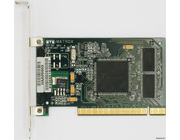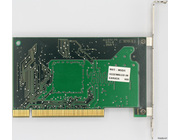Matrox PowerVR PCX-2
The PowerVR; 3Dfx' rival. Not much people remember, or ever heard of, the PowerVR so I'll give you a short history:
The chip was announced mid 1996 and cards using it were available around late 1996 / early 1997. Matrox and VideoLogic both sold cards using the PowerVR chip. Two versions of the PowerVR chip were made available for the PC platform. The NEC PowerVR PCX1 and NEC PowerVR PCX2. PCX1 is about 50% slower as PCX and uses a 0.50 micron manufacturing process whereas the PCX2 uses 0.35 micron. I'm not sure but PCX1 probably ran at 60MHz, PCX2 at 66MHz. Other thing is that PCX1 is not able to do bilinear filtering.
Cards that used PCX1:
- VideoLogic Apocalypse 3D
Cards that used PCX2:
- VideoLogic Apocalypse 3Dx
- VideoLogic Apocalypse 5D
- VideoLogic Apocalypse 5D Sonic
- Matrox m3D
- Gateway Destination PC 3D Graphics (P/N 6000627; OEM)
The Matrox m3D and VideoLogic Apocalypse 3Dx are technically the same. Back in the old days the Matrox card was cheaper due to a smaller game-pack. Matrox also had tweaked drivers so their m3D would work correct with the Matrox 2D boards.
Just like 3Dfx, the PowerVR is an add-on card as well. The PCX2 version (as seen on the photo's) is small and doesn't need a VGA pass-through cable like the Voodoo card would. Communication goes through the PCI bus. PowerVR also needed an API named PowerSGL. All the games that supported the PowerVR were programmed for PowerSGL. Again just like 3Dfx with the 3Dfx Glide API.
Things like Direct3D were in early stage back then and therefor games were specifically optimized to use a 3D add-on card. This works fine for one card but if a developer wants to support more cards he/she has to program another executable which is specifically designed for the 3D card. And logically the card that supported the most games and was widely available survived the market- and that was not the NEC PowerVR PCX.
PowerVR technology wasn't 'worthless' even though it didn't really make it through the PC-market. The Sega Dreamcast uses the CLX2 and eventually the Kyro (PowerVR3) chip would appear for the PC-market but that was not until 2001.
 Pentium Pro 200
Pentium Pro 200

